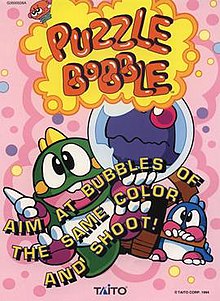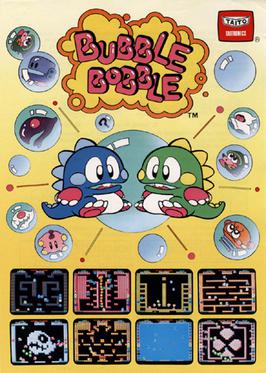
Bubble Bobble is a 1986 platform game developed and published by Taito for arcades. It was distributed in the United States by Romstar, and in Europe by Electrocoin. Players control Bub and Bob, two dragons that set out to save their girlfriends from a world known as the Cave of Monsters. In each level, Bub and Bob must defeat each enemy present by trapping them in bubbles and popping, who turn into bonus items when they hit the ground. There are 100 levels total, each becoming progressively more difficult.

Rainbow Islands: The Story of Bubble Bobble 2 (レインボーアイランド) is a 1987 arcade video game developed and published by Taito, with the arcade version licensed to Romstar for North American manufacturing and distribution. The game is the sequel to Bubble Bobble from the previous year, and it is the second of four arcade games in the series. The game was ported to home computers and home video game consoles.

Don Doko Don is a platform arcade game developed and released by Taito in 1989. In the game, the player(s) control two lumberjacks, Bob and Jim, with the objective being to clear the screen of all the enemies. Bob and Jim use their mallets to stun the enemies, pick up the enemies, then throw them at a wall, or other enemies to kill them off, resulting in bonus points. Bonus items also appear during stages that will have varying effects on the players.

The Fairyland Story is a platform arcade video game developed and published by Taito in 1985. In the game, the player controls the witch Ptolemy, with the objective being to clear the screen of all enemies. Ptolemy can use her wand to turn the enemies into large cakes, which she can then push off of platforms onto other enemies, which will squash them and award bonus points. Various items that increase Ptolemy's projectile radius, as well as kill multiple enemies at the same time, will also appear throughout the stages.

Puzzle Bobble 2 is a tile-matching video game by Taito. The first sequel to Puzzle Bobble, it is also known in Europe and North America as Bust-A-Move Again for arcades and Bust-A-Move 2: Arcade Edition for home consoles. Released into the arcades in 1995, home conversions followed for the PlayStation, Sega Saturn, Nintendo 64, and Windows platforms. The game was included in Taito Legends 2, but the US arcade version was included on the US PS2 version instead. Further ports for the Nintendo Switch, PlayStation 4, and Xbox One were released by City Connection alongside Puzzle Bobble 3 in February 2023.
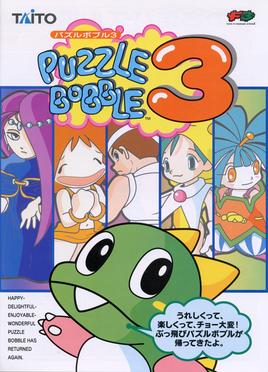
Puzzle Bobble 3 is an action puzzle video game developed by Taito. The second sequel to Puzzle Bobble, it was released for arcades in September 1996 and later ported to the Sega Saturn, PlayStation, Game Boy, Nintendo 64 and Microsoft Windows. Like its predecessors, the player is tasked with shooting balls at groups of balls, creating groups of three or more, which are then removed from play. Further ports for the Nintendo Switch, PlayStation 4 and Xbox One were released in February 2023 by City Connection alongside Puzzle Bobble 2.
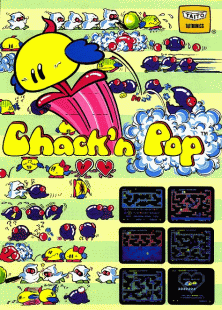
Chack'n Pop is a platform arcade game developed and released by Taito in 1984. In the game, the player controls a small yellow creature, Chack'n, with the objective being to retrieve hearts from a cave, all while avoiding the enemies contained within them. Chack'n also has the ability to deploy bombs, which can kill said enemies, which can bring bonuses depending on if all or none of the enemies have been killed.
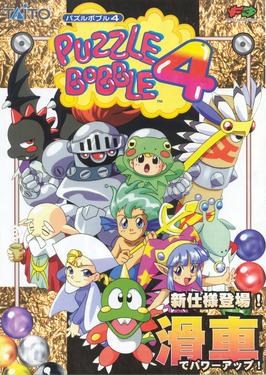
Puzzle Bobble 4 is the third sequel to the video game Puzzle Bobble and is the final appearance of the series on the PlayStation and the only appearance of the series on the Dreamcast.

Sonic Blast Man is a video game franchise by Taito starring the titular superhero, Sonic Blastman. The game originally started as an arcade video game in 1990, but eventually made its way to the SNES in 1992, with much different gameplay. Both versions received a sequel.

Super Puzzle Bobble, released as Super Bust-A-Move in Europe and North America, is a puzzle video game in the Puzzle Bobble series. It was developed by Taito, and released on November 27, 2000 by Acclaim Entertainment for the PlayStation 2, and by CyberFront and EON Digital Entertainment for Windows in 2001. It was later ported to the Game Boy Advance that same year, the Japanese version under the name Super Puzzle Bobble Advance. It was re-released in Japan for the PlayStation 2 in 2004 as part of Super Puzzle Bobble DX, which is Volume 62 of the Japan-exclusive Simple 2000 Series. This compilation includes a few graphical enhancements.
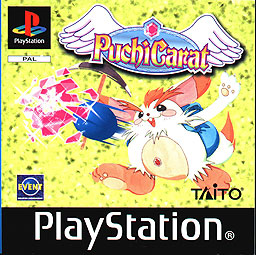
Puchi Carat is a 1997 video game by Taito.
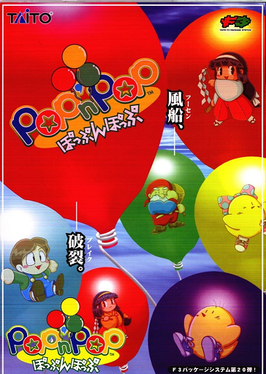
Pop'n Pop is a puzzle video game released in arcades by Taito in February 1998. It features characters from Taito games Rainbow Islands, Kiki Kaikai, Don Doko Don, and The NewZealand Story,

Arkanoid DS is a breakout video game developed by Taito and published by Square Enix for the Nintendo DS. It was released on December 6, 2007.

Syvalion is an arcade shooter video game released by Taito in 1988 and designed by Fukio Mitsuji, creator of Bubble Bobble. The player controls a golden metal dragon which flies around, breathing fire at its enemies while collecting power-ups to recharge its fire. The enemies are robots and tanks. At the end of each level, the player fights a boss.
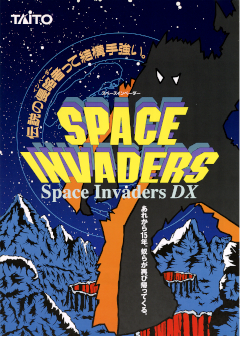
Space Invaders DX is a 1993 fixed shooter arcade game developed and published in Japan by Taito. It has been re-released for several consoles since, including the Super Nintendo Entertainment System, PC Engine CD, and Sega Saturn — several of these conversions use the name Space Invaders: The Original Game. The player assumes control of a laser base that must fend off waves of incoming enemies, who march down in formation towards the bottom of the screen. It is the fifth entry in the long-running Space Invaders series. DX contains four variations of the original Space Invaders, in addition to a multiplayer mode and a "Parody Mode" that replaces the characters with those from other Taito franchises. Home ports of DX received mixed reviews for their high price point and general lack of content.

Puzzle Bobble Plus!, known in North America as Bust-A-Move Plus!, and in Japan as Puzzle Bobble Wii, is a video game developed by Taito for WiiWare. It was first released in Japan on April 7, 2009, and later in the PAL regions on June 26, 2009, and in North America on July 6, 2009.

Space Bust-A-Move is a puzzle video game developed by Lancarse and published by Taito in Japan, and Square Enix worldwide for the Nintendo DS. It was first released in Japan under the title Space Puzzle Bobble on December 18, 2008. It was later released in North America under the title Space Bust-A-Move on July 28, 2009, and in Europe under the title Puzzle Bobble Galaxy on August 28, 2009. As with Arkanoid DS, Space Invaders Extreme and Space Invaders Extreme 2, the game is compatible with Taito's paddle controller.
Survios is an American virtual reality game developer and software publisher based in Los Angeles, California. The company develops virtual reality software and games, including the titles Raw Data and Sprint Vector. Survios was created by graduates from the University of Southern California's Mixed Reality Lab, where they worked together on Project Holodeck. The company has raised over $54 million in venture funding led by Shasta Ventures, Lux Capital and Metro-Goldwyn-Mayer.

Super Puzzle Bobble 2, released as Super Bust-A-Move 2 in North America and Europe, is a puzzle video game in the Puzzle Bobble series developed by Taito, and was released in 2002 for the PlayStation 2.

Touhou Spell Bubble is a rhythm based competitive arcade puzzle game developed in 2020 by Taito as an officially licensed spin-off in the Touhou Project series. The gameplay is similar to that of the Puzzle Bobble series, which Taito also developed. The company has referred to the game as "Puzzle Bobble meets Touhou Project," implying that they consider it to also be a spinoff of both series.
